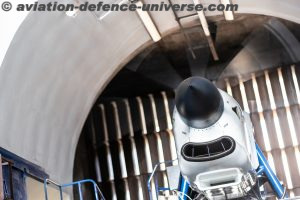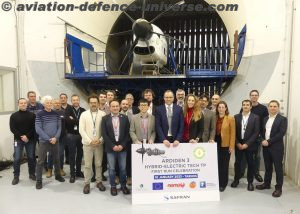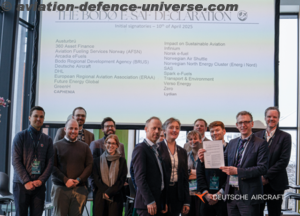
Paris. 23 February 2023. Safran Helicopter Engines has successfully completed ground tests of a “more-electric” variant of its Tech TP turboprop engine at its Tarnos facility. The Ardiden 3-based technological demonstrator incorporates technologies from Clean Sky1 ACHIEVE project, resulting in more efficient and more sustainable operating modes.
ACHIEVE (Advanced mechatronics devices for a novel turboprop electric starter-generator and health monitoring system) is a Clean Sky project coordinated by the UK University of Nottingham and supported by NEMA Ltd and Power System Technology. Within this project, an innovative and more powerful electrical motor-generator has been developed and integrated in the Tech TP propeller and accessory gearbox (PAGB). This device comprises an electrical machine, an electronic power converter and associate controllers.
It allows to drive the propeller electrically, enabling new operating modes such as taxying without using power directly from the main turbine engines or in-flight electric assistance. This saves fuel and reduces noise and emissions, resulting in more sustainable operations.
 Didier Nicoud, Safran Helicopter Engines EVP Engineering said: “Leveraging hybrid electric technologies is an important pillar in our strategy to reduce fuel consumption and carbon emissions. ACHIEVE Tech TP also paves the way for a new Clean Aviation demonstrator managed by the HE-ART (Hybrid-Electric propulsion system for regional AiRcrafT) consortium. By 2025 HE-ART, bringing together 38 partners (with Safran Helicopter Engines as technical coordinator), plans to ground test a hybrid electric propulsion engine intended for regional turboprop aircraft.”
Didier Nicoud, Safran Helicopter Engines EVP Engineering said: “Leveraging hybrid electric technologies is an important pillar in our strategy to reduce fuel consumption and carbon emissions. ACHIEVE Tech TP also paves the way for a new Clean Aviation demonstrator managed by the HE-ART (Hybrid-Electric propulsion system for regional AiRcrafT) consortium. By 2025 HE-ART, bringing together 38 partners (with Safran Helicopter Engines as technical coordinator), plans to ground test a hybrid electric propulsion engine intended for regional turboprop aircraft.”
Tech TP is a technology demonstrator developed as part of the European Clean Sky 2 research program. It features 18% lower fuel consumption and CO2 emissions compared to similar engines currently in service, as evaluated by Piaggio Aerospace on a virtual 19-seater commuter installation. It is optimized for operations at medium and high altitudes (45,000 feet) and will be particularly easy to operate, thanks to an innovative throttle lever interfaced with a Full-Authority Digital Engine and Propeller Control (FADEPC) computer. More than 20 partners from eight European countries are contributed to this project.



























































































































